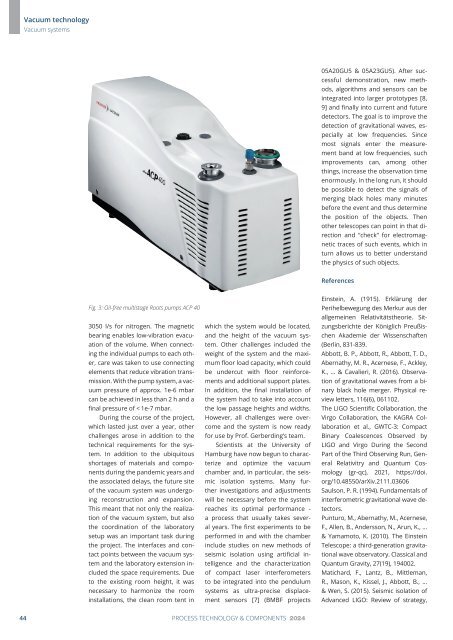PuK - Process Technology & Components 2024
A technical trade magazine with a history of more than 60 years.
A technical trade magazine with a history of more than 60 years.
You also want an ePaper? Increase the reach of your titles
YUMPU automatically turns print PDFs into web optimized ePapers that Google loves.
Vacuum technology<br />
Vacuum systems<br />
05A20GU5 & 05A23GU5). After successful<br />
demonstration, new methods,<br />
algorithms and sensors can be<br />
integrated into larger prototypes [8,<br />
9] and finally into current and future<br />
detectors. The goal is to improve the<br />
detection of gravitational waves, especially<br />
at low frequencies. Since<br />
most signals enter the measurement<br />
band at low frequencies, such<br />
improvements can, among other<br />
things, increase the observation time<br />
enormously. In the long run, it should<br />
be possible to detect the signals of<br />
merging black holes many minutes<br />
before the event and thus determine<br />
the position of the objects. Then<br />
other telescopes can point in that direction<br />
and “check” for electromagnetic<br />
traces of such events, which in<br />
turn allows us to better understand<br />
the physics of such objects.<br />
References<br />
Fig. 3: Oil-free multistage Roots pumps ACP 40<br />
3050 l/s for nitrogen. The magnetic<br />
bearing enables low-vibration evacuation<br />
of the volume. When connecting<br />
the individual pumps to each other,<br />
care was taken to use connecting<br />
elements that reduce vibration transmission.<br />
With the pump system, a vacuum<br />
pressure of approx. 1e-6 mbar<br />
can be achieved in less than 2 h and a<br />
final pressure of < 1e-7 mbar.<br />
During the course of the project,<br />
which lasted just over a year, other<br />
challenges arose in addition to the<br />
technical requirements for the system.<br />
In addition to the ubiquitous<br />
shortages of materials and components<br />
during the pandemic years and<br />
the associated delays, the future site<br />
of the vacuum system was undergoing<br />
reconstruction and expansion.<br />
This meant that not only the realization<br />
of the vacuum system, but also<br />
the coordination of the laboratory<br />
setup was an important task during<br />
the project. The interfaces and contact<br />
points between the vacuum system<br />
and the laboratory extension included<br />
the space requirements. Due<br />
to the existing room height, it was<br />
necessary to harmonize the room<br />
installations, the clean room tent in<br />
which the system would be located,<br />
and the height of the vacuum system.<br />
Other challenges included the<br />
weight of the system and the maximum<br />
floor load capacity, which could<br />
be undercut with floor reinforcements<br />
and additional support plates.<br />
In addition, the final installation of<br />
the system had to take into account<br />
the low passage heights and widths.<br />
However, all challenges were overcome<br />
and the system is now ready<br />
for use by Prof. Gerberding’s team.<br />
Scientists at the University of<br />
Hamburg have now begun to characterize<br />
and optimize the vacuum<br />
chamber and, in particular, the seismic<br />
isolation systems. Many further<br />
investigations and adjustments<br />
will be necessary before the system<br />
reaches its optimal performance -<br />
a process that usually takes several<br />
years. The first experiments to be<br />
performed in and with the chamber<br />
include studies on new methods of<br />
seismic isolation using artificial intelligence<br />
and the characterization<br />
of compact laser interferometers<br />
to be integrated into the pendulum<br />
systems as ultra-precise displacement<br />
sensors [7] (BMBF projects<br />
Einstein, A. (1915). Erklärung der<br />
Perihelbewegung des Merkur aus der<br />
allgemeinen Relativitätstheorie. Sitzungsberichte<br />
der Königlich Preußischen<br />
Akademie der Wissenschaften<br />
(Berlin, 831-839.<br />
Abbott, B. P., Abbott, R., Abbott, T. D.,<br />
Abernathy, M. R., Acernese, F., Ackley,<br />
K., ... & Cavalieri, R. (2016). Observation<br />
of gravitational waves from a binary<br />
black hole merger. Physical review<br />
letters, 116(6), 061102.<br />
The LIGO Scientific Collaboration, the<br />
Virgo Collaboration, the KAGRA Collaboration<br />
et al., GWTC-3: Compact<br />
Binary Coalescences Observed by<br />
LIGO and Virgo During the Se cond<br />
Part of the Third Observing Run, General<br />
Rela tivitry and Quantum Cosmology<br />
(gr-qc), 2021, https://doi.<br />
org/10.48550/arXiv.2111.03606<br />
Saulson, P. R. (1994). Fundamentals of<br />
interferometric gravitational wave detectors.<br />
Punturo, M., Abernathy, M., Acernese,<br />
F., Allen, B., Andersson, N., Arun, K., ...<br />
& Yamamoto, K. (2010). The Einstein<br />
Telescope: a third-generation gravitational<br />
wave observatory. Classical and<br />
Quantum Gravity, 27(19), 194002.<br />
Matichard, F., Lantz, B., Mittleman,<br />
R., Mason, K., Kissel, J., Abbott, B., ...<br />
& Wen, S. (2015). Seismic isolation of<br />
Advanced LIGO: Review of strategy,<br />
44 PROCESS TECHNOLOGY & COMPONENTS <strong>2024</strong>

















